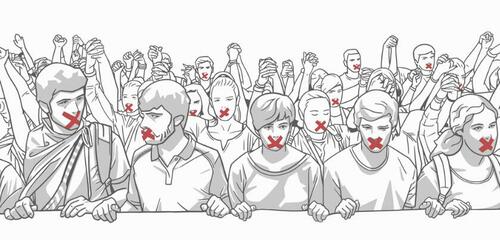
So much for colleges and universities being institution for the free exchange of ideas.
There is a new poll out and it is strikingly similar to the polls previously featured on this blog on free speech and intellectual diversity in higher education. The Buckley annual survey found that almost 60 percent of college students fear sharing an opinion in classrooms or on campuses. That tracks other polls by different groups. Yet, colleges and universities continue to exclude Republican and conservative faculty members and maintain environments of speech intolerance.The poll shows a sharp increase from just last year with 63% reporting feeling intimidated in sharing opinions different than their peers. That is almost identical to the 65 percent found in other polls.
The poll of over 800 students included many liberal students, as reflected in the 67 percent who would require all professors and administrators to make statements in favor of diversity, equity, and inclusion. Half of students believe “America is inextricably linked to white supremacy” and another 33 percent would prefer to live in a socialist system.
The poll tracks earlier polls showing a rising view of viewpoint intolerance that now characterizes higher education in America. That intolerance is reflected in the overwhelmingly Democratic and liberal makeup of faculties.
A new survey of 65 departments in various states found that 33 do not have a single registered Republican. For these departments, the systemic elimination of Republican faculty has finally reached zero, but there is still little recognition of the crushing bias reflected in these numbers. Others, as discussed below, have defended the elimination of conservative or Republican faculty as entirely justified and commendable. Overall, registered Democrats outnumbered registered Republicans by a margin of over 10-1.
The survey found 61 Republican professors across 65 departments at seven universities while it also found 667 professors identified as Democrats based on their political party registration or voting history.
While there may be a couple professors missed on either side of this ideological divide, most faculty will privately admit that it is rare to find self-identified Republicans or conservatives on many faculties. Most faculties are overwhelmingly Democratic and liberal. Diversity generally runs from the left to the far left.
Another survey found that only nine percent of law professors identified as conservative. The virtual absence of Republican or conservative members on many faculties are just shrugged off by many academics. It is the subject of my recent publication in the Harvard Journal of Law and Public Policy. The article entitled “Harm and Hegemony: The Decline of Free Speech in the United States.”
Notably, a 2017 study found 15 percent of faculties were conservative. This is the result of years of faculty replicating their own ideological preferences and eradicating the diversity that once existed on faculties. When I began teaching in the 1980s, faculties were undeniably liberal but contained a significant number of conservative and libertarian professors. It made for a healthy and balanced intellectual environment. Today such voices are relatively rare and faculties have become political echo chambers, leaving conservatives and Republican students increasingly afraid to speak openly in class.
The trend is the result of hiring systems where conservative or libertarian scholars are often rejected as simply “insufficiently intellectually rigorous” or “not interesting” in their scholarship. This can clearly be true with individual candidates but the wholesale reduction of such scholars shows a more systemic problem. Faculty insist that there is no bias against conservatives, but the obviously falling number of conservative faculty speaks for itself.